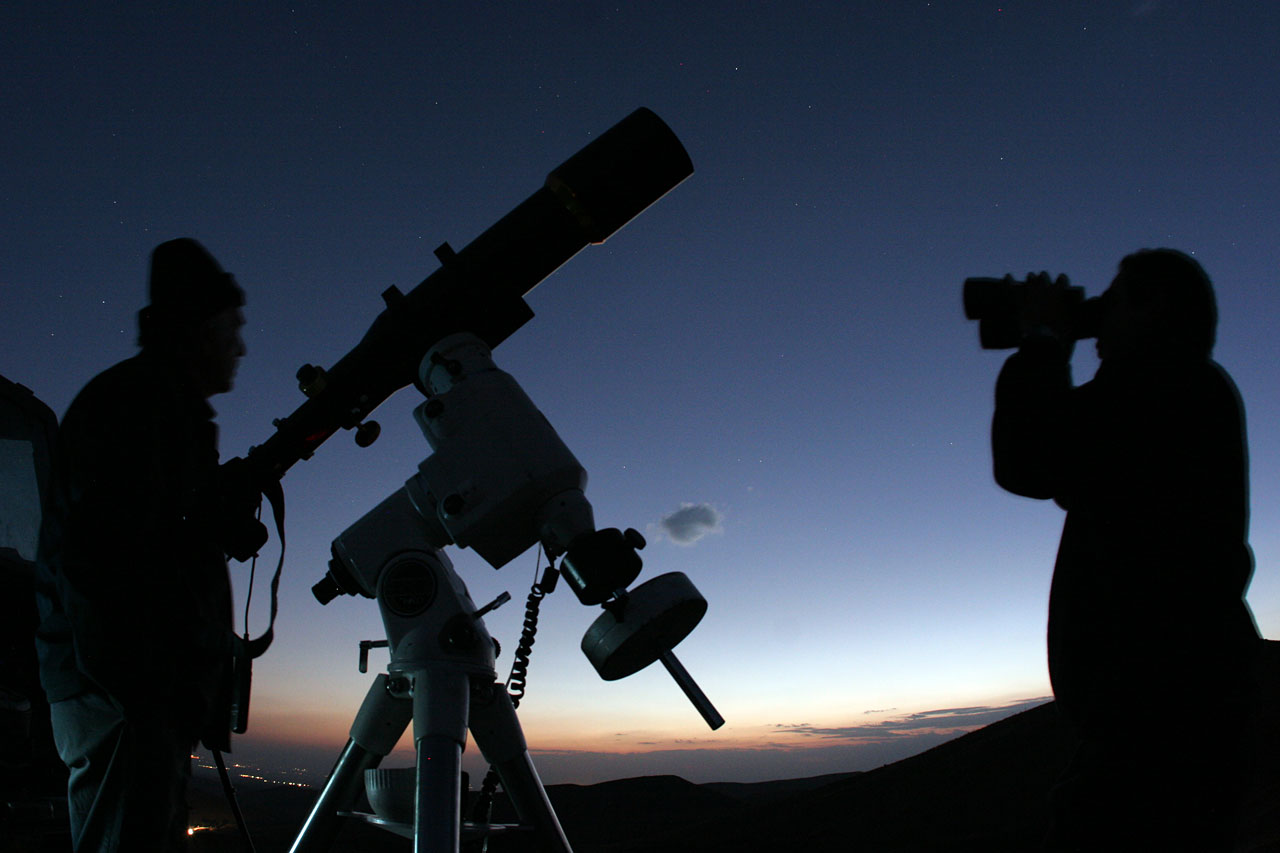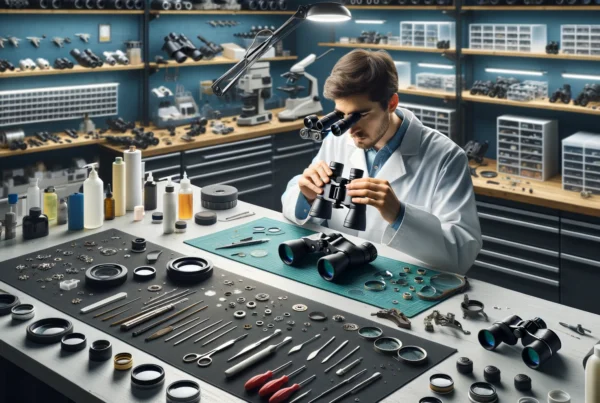Contents
- Telescope for Space Observation
- Advantages of Telescopes
- Binoculars for Space Observation
- Advantages of Binoculars
- Factors to Consider:
- When to Use Telescopes?
- When to Use Binoculars?
- Using Both Telescopes and Binoculars
- Pros & Cons of Telescope
- Pros & Cons of Binoculars
- Frequently Asked Questions (FAQ’s)
- Bottom Line
When we gaze up at the night sky, our imagination takes flight, yearning to explore the mysteries of the universe. To embark on this cosmic journey, we need a companion—a tool to unveil the wonders of space.
Both telescopes and binoculars can be used to observe space, but which one is better depends on what you want to observe and your personal preferences.
But in the eternal debate between telescopes and binoculars, which one is truly superior for observing the vastness above? Buckle up as we embark on an adventure to discover the answer.
Telescope for Space Observation

Telescopes, the stalwarts of astronomical exploration, unlock the celestial treasures hidden beyond the naked eye’s reach. These powerful optical devices possess the ability to gather light and magnify distant objects, revealing mesmerizing details that bewilder the imagination.
Advantages of Telescopes
Telescopes are designed specifically for astronomical use and can provide high magnification and detailed views of celestial objects. They typically have larger apertures, long focal lengths, and high magnification eyepieces, which allow you to bring deep space objects closer and sharper into focus.
Telescopes also offer more flexibility for stargazing and can be used for astrophotography, whereby cameras or smartphones can be attached to photograph or video deep space explorations.
Binoculars for Space Observation

While telescopes dominate the realm of space observation, binoculars carve out their own niche, offering a portable and accessible alternative for stargazing enthusiasts.
Advantages of Binoculars
- Binoculars are much easier to learn to use than a telescope and are more portable due to their small size and lightweight.
- They are also less expensive than telescopes.
- Binoculars provide a wider field of view, making it easier to find celestial objects, and they let you use both eyes, providing surer, more natural views.
- Binoculars are also great for observing the Moon, planets, and star clusters.
Factors to Consider:
To determine which instrument suits your needs, it is essential to consider several factors when deciding between telescopes and binoculars.
Observational Requirements:
Assess your level of interest and purpose of observation. Are you an amateur stargazer seeking casual enjoyment, or do you aspire to engage in professional astronomical research? Understanding your goals will help you choose the instrument that aligns with your aspirations.
Magnification and Light Gathering:
Telescopes excel in offering higher magnification and light-gathering capabilities. If your primary focus is observing distant galaxies, nebulae, or other faint deep-sky objects, a telescope is the ideal choice. Binoculars, on the other hand, provide a wider field of view, sacrificing some magnification power for a more immersive experience.
Portability and Ease of Use:
Binoculars are convenient for on-the-go observers, offering ease of use and portability. If you value the ability to observe spontaneously from different locations or desire a hassle-free setup, binoculars should be strongly considered. Telescopes, especially larger models, may require tripods, mounts, and more time for assembly and alignment.
Budget Considerations:
Binoculars tend to be more affordable, making them an accessible entry point for beginners or casual enthusiasts. Telescopes, however, vary widely in price, with more advanced models and larger apertures commanding a higher cost. Determine your budget and evaluate the investment you are willing to make in your astronomical journey.
When to Use Telescopes?
Telescopes are best for observing deep space objects, such as galaxies, nebulae, and star clusters. They are also ideal for astrophotography and for those who want to take their stargazing to the next level.
When to Use Binoculars?
Binoculars are great for beginners and for those who want to observe the Moon, planets, and star clusters. They are also more portable and easier to use than telescopes, making them a great option for those who want to stargaze on the go.
Using Both Telescopes and Binoculars
Using both telescopes and binoculars can provide a more comprehensive stargazing experience. Telescopes can be used to observe deep space objects, while binoculars can be used to observe the Moon, planets, and star clusters.
Pros & Cons of Telescope
Pros of Telescope:
- Greater magnification: Telescopes have the ability to provide higher levels of magnification, allowing for detailed observations of distant celestial objects.
- Enhanced light-gathering capabilities: Telescopes are designed to gather more light, making it easier to observe faint and distant objects in the night sky.
- Specialized for astronomical research: Telescopes come in various sizes and types, catering to different observational needs and providing options for specific astronomical pursuits.
- Superior for studying deep-sky objects: Telescopes excel at observing faint deep-sky objects like galaxies, nebulae, and star clusters, unveiling their intricate details and structures.
Cons of Telescope:
- Bulky and less portable: Telescopes, especially larger models, can be heavy and require assembly, making them less portable and more cumbersome to transport.
- Higher cost: Telescopes can range from affordable options for beginners to high-end models used by professionals, making them a more significant investment compared to binoculars.
- Steeper learning curve: Operating telescopes may require some knowledge and experience to align and adjust the instrument correctly for optimal observations.
Pros & Cons of Binoculars
Pros of Binoculars:
- Portability: Binoculars are lightweight and compact, making them highly portable and easy to carry around for spontaneous observations or while traveling.
- Wider field of view: Binoculars offer a broader field of view, allowing for a more immersive experience and providing a better sense of the overall celestial landscape.
- Ease of use: Binoculars are user-friendly, requiring minimal setup and adjustment, making them accessible to beginners and casual stargazers.
- Cost-effective: Binoculars are generally more affordable compared to telescopes, making them a budget-friendly option for those starting out in space observation.
Cons of Binoculars:
- Limited magnification: Binoculars have a maximum magnification limit due to their compact size, making them less suitable for detailed observations of faint or distant objects.
- Not ideal for deep-sky observation: Binoculars are better suited for observing larger celestial objects like the Moon, planets, and star clusters. They may not provide the level of detail required for studying faint deep-sky objects.
- Limited specialization: While binoculars offer versatility, they do not offer the same level of specialization as telescopes, which may limit their effectiveness for specific astronomical research purposes.
Frequently Asked Questions (FAQ’s)
What are the key factors to consider when deciding between a telescope and binoculars for space observation?
Several factors come into play when making this decision. It is essential to consider your observational requirements, such as your level of interest and purpose of observation. Additionally, factors like magnification and light-gathering capabilities, portability, and ease of use, and budget considerations should be taken into account.
Which option provides better magnification, telescopes, or binoculars?
Telescopes generally offer higher magnification capabilities compared to binoculars. Telescopes are designed to provide detailed views of distant celestial objects, making them suitable for observing faint and distant phenomena like galaxies and nebulae. Binoculars, while offering lower magnification, provide a wider field of view, which can enhance the overall viewing experience and are better suited for observing larger objects like the Moon and planets.
Are telescopes or binoculars more suitable for beginners in space observation?
Binoculars are often recommended for beginners due to their ease of use, portability, and affordability. They offer a straightforward entry point into space observation and allow beginners to explore the night sky, observe bright objects like the Moon and planets, and develop a foundational understanding of astronomy. Telescopes, while more powerful, may have a steeper learning curve and require more knowledge and experience to operate effectively.
Which option is more portable, telescopes, or binoculars?
Binoculars are generally more portable compared to telescopes. They are lightweight, compact, and easy to carry, making them suitable for on-the-go observations and spontaneous stargazing sessions. Telescopes, especially larger models, can be bulkier and require more setup time. They may need tripods, mounts, and additional equipment for stability, making them less convenient for frequent transportation.
Are telescopes or binoculars more expensive?
Binoculars are typically more affordable compared to telescopes. Binoculars come in a wide price range, including budget-friendly options suitable for beginners. On the other hand, telescopes vary widely in price, ranging from entry-level models to advanced and high-end instruments used by professional astronomers. The cost of telescopes often increases with larger apertures and more advanced features.
Can binoculars be used for deep-sky observation?
Binoculars are better suited for observing larger celestial objects like the Moon, planets, and wide-field star clusters. While they may provide glimpses of certain deep-sky objects like bright nebulae or galaxies, they generally lack the high magnification and light-gathering capabilities required for detailed observations of faint deep-sky objects. Telescopes, with their larger apertures and specialized designs, are more effective for studying deep-sky phenomena.
Bottom Line
In conclusion, both telescopes and binoculars have their advantages and disadvantages when it comes to observing space. Telescopes are better for observing deep space objects and for astrophotography, while binoculars are better for beginners and for observing the Moon, planets, and star clusters. Ultimately, the choice between telescopes and binoculars comes down to personal preference and what you want to observe.
To be Noted: It’s worth noting that putting telescopes into space has its advantages, as it gets around the Earth’s atmosphere so that we can get a clearer view of the planets, stars, and galaxies that we are studying. Space telescopes have the advantage of being above the blurring effects of the Earth’s atmosphere, and wider wavelengths of the electromagnetic spectrum can be observed such as infrared, ultraviolet, x-rays, and gamma rays.

A Binoculars enthusiast, who love exploring skies and watching birds. It is my hobby to collect Binoculars of different kinds and try to explore the world through various lenses. This is all I do to explore happiness by magnifying my beautiful world.




